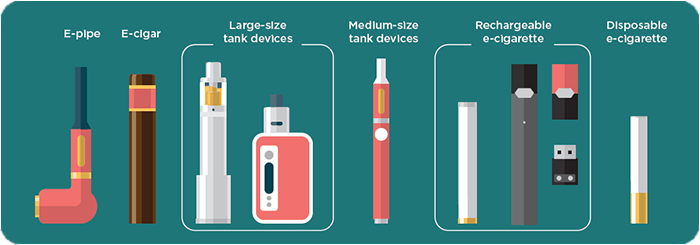PROBLEM WITH THIS WEBPAGE?
Report an accessibility problem
To report another problem, please contact jennifer.schnuck@marquette.edu.
E-cigarettes are battery-powered devices that work by heating a liquid into an aerosol that the user inhales and exhales. The e-cigarette liquid typically contains nicotine, propylene glycol, glycerin, flavorings, and other chemicals. Nicotine is the addictive drug found in regular cigarettes and other tobacco products. Research shows that e-cigarette aerosol often contains substances that can be harmful, including flavoring chemicals (like diacetyl, which is linked to lung disease), metals (like lead), and other cancer-causing chemicals.

Are e-cigarettes just as bad as smoking cigarettes?
Even though there are less cancer-causing chemicals in e-cigarettes compared to tobacco, they contain chemicals that are far from benign, e.g., formaldehyde, a known carcinogen, is formed during inhalation in tank system e-cigarettes. Nicotine can lead to severe neurodevelopmental impairments in young users, is highly addictive, and can prime the brain to be more prone to addiction of other drugs such as methamphetamine and cocaine. A solvent known as propylene glycol is known to cause lung disease. Second hand exposure to vapor clouds exposes other to harmful chemicals.
Why is chewing tobacco bad for you? Don’t they contain less carcinogens than cigarettes?
Not only can smokeless tobacco result in similar physiological disorders as cigarettes, smokeless tobacco has been found to damage pivotal metabolic enzymes2. The use of smokeless tobacco has been proven to cause DNA mutations that can lead to pancreatic cancer, oral cancer, esophageal cancer, and more3.
What on-campus locations are affected by this policy?
The policy encompasses all of Marquette University. This includes all indoor and outdoor campus spaces including campus buildings, grounds, exterior open spaces, green spaces, parking lots (including inside a vehicle if parked in an MU lot), university-owned or leased vehicles, on-campus sidewalks (not bordering a city street), on-campus driveways and other paved areas, athletic facilities, practice facilities, and recreational spaces.
On July 19, 2019 an ordinance was passed by the Common Council of the City of Milwaukee stating that the use of electronic smoking devices and electronic smoking device paraphernalia is not allowed in places where smoking is prohibited by state law, i.e. within all university buildings, per Wisconsin Act 12, with penalties to apply.
What exactly does tobacco free mean?
Tobacco is defined to include any lighted cigarette (clove, bidis, kreteks), cigars, cigarillos, pipes, hookah products, and any other smoking product. This also includes any smokeless, spit or spit less, dissolvable, or inhaled tobacco products; including but not limited to dip, chew, snuff or snus, in any form (orbs, sticks pellets, etc.)3. Nicotine products not approved by the Food and Drug Administration as a smoking cessation product, such as e-cigarettes, are also prohibited.
Are vapes included in the policy, and if so why?
Vaping is indeed banned on campus, as it is not only a nicotine product but also produces vapor clouds that affect others. Electronic nicotine delivery tanks contain an unknown level of toxic chemicals. With the surge of electronic nicotine systems and no existing government regulation of the ingredients, research is ongoing to identify the toxic chemicals contained within the tanks6.
Whom does this policy affect?
This policy affects everyone who enters Marquette University property. This includes staff, faculty, students, employees, visitors.
References:
(n.d.). Health risks of secondhand smoke: What is secondhand smoke? American Cancer Society.
Retrieved from https://www.cancer.org/cancer/cancer-causes/tobacco-and-cancer/secondhand-smoke.html
(2007). IARC monographs on the evaluation of carcinogenic risks to humans: Smokeless tobacco and some tobacco-specific n-nitrosamines (Vol. 89). Lyon, France: International Agency for Research on Cancer.
Rimer, S. (n.d.). Behind the vapor: Chasing the facts about e-cigarettes health risks. Boston University Research. Retrieved from http://www.bu.edu/research/articles/behind-the-vapor/
(n.d.). Smokeless tobacco: Health effects. Centers for Disease Control and Prevention. Retrieved from www.cdc.gov/tobacco/data_statistics/fact_sheets/
smokeless/health_effects/index.htm
Stöppler, M. C. (n.d.). Chewing tobacco (Smokeless tobacco, snuff). MedicineNet. Retrieved from www.medicinenet.com/smokeless_tobacco/article.htm
Vapentine, L. (2016, September 22). E-cigarettes vs. vaporizers: What's the difference? Vapor4Life. Retrieved from www.vapor4life.com/blog/e-cigarettes-vs-vaporizers-whats-difference/
Are you a student that is interested in or ready to quit tobacco and/or nicotine products?
E-Cigarette & Vaping Resources
If you have more questions about quitting please call the Medical Clinic at (414) 288-7184 to schedule an appointment with one of our medical care providers.